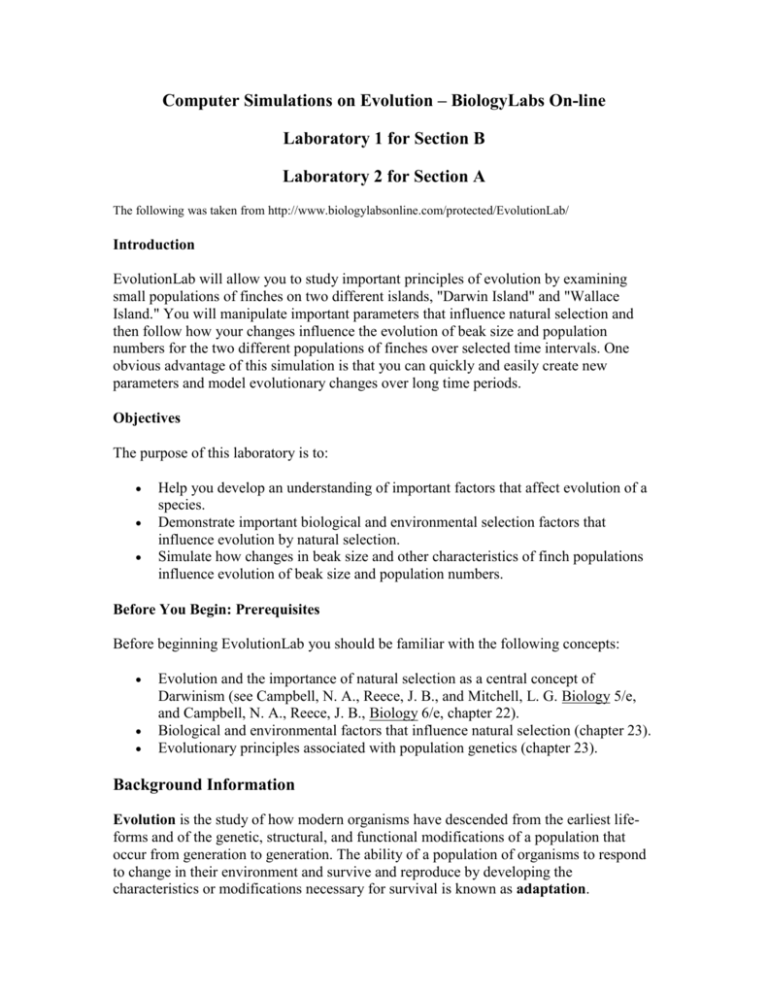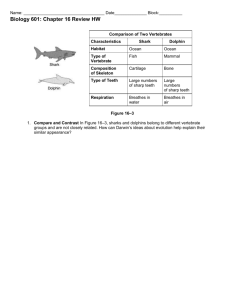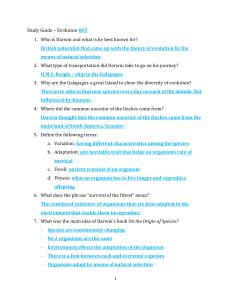Computer Simulations on Evolution
advertisement

Computer Simulations on Evolution – BiologyLabs On-line Laboratory 1 for Section B Laboratory 2 for Section A The following was taken from http://www.biologylabsonline.com/protected/EvolutionLab/ Introduction EvolutionLab will allow you to study important principles of evolution by examining small populations of finches on two different islands, "Darwin Island" and "Wallace Island." You will manipulate important parameters that influence natural selection and then follow how your changes influence the evolution of beak size and population numbers for the two different populations of finches over selected time intervals. One obvious advantage of this simulation is that you can quickly and easily create new parameters and model evolutionary changes over long time periods. Objectives The purpose of this laboratory is to: Help you develop an understanding of important factors that affect evolution of a species. Demonstrate important biological and environmental selection factors that influence evolution by natural selection. Simulate how changes in beak size and other characteristics of finch populations influence evolution of beak size and population numbers. Before You Begin: Prerequisites Before beginning EvolutionLab you should be familiar with the following concepts: Evolution and the importance of natural selection as a central concept of Darwinism (see Campbell, N. A., Reece, J. B., and Mitchell, L. G. Biology 5/e, and Campbell, N. A., Reece, J. B., Biology 6/e, chapter 22). Biological and environmental factors that influence natural selection (chapter 23). Evolutionary principles associated with population genetics (chapter 23). Background Information Evolution is the study of how modern organisms have descended from the earliest lifeforms and of the genetic, structural, and functional modifications of a population that occur from generation to generation. The ability of a population of organisms to respond to change in their environment and survive and reproduce by developing the characteristics or modifications necessary for survival is known as adaptation. Understanding how life evolves is a central concept in biology. The incredible diversity of living organisms that exists and their adaptations to their environment are the direct result of evolution that has occurred over very long periods of time. Many scientists have contributed to our modern-day understanding of evolution. One of the early pioneers of evolution was the French biologist Jean Baptiste de Lamarck. Working in the early 1800s, Lamarck compared fossilized forms of invertebrate organisms and noted that younger fossils showed advanced structural characteristics compared with older fossils. Lamarck suggested that younger fossils displayed adaptations, or modifications of structures, that were indicative of an increase in an organism's complexity. He proposed that these modifications arose from the use or disuse of body parts. He also hypothesized that certain structural features developed in response to an organism's environment and that many of these acquired characteristics could be inherited by offspring. One classic example of such modifications suggested by Lamarck involves the long neck of giraffes. He proposed that the earliest giraffes were relatively short-necked animals that were forced to stretch their necks to eat their desired food, leaves that grew at the tops of trees. Over time, such stretching would produce animals with small increases in the length of their necks. This trait would be passed on to future offspring, which would also show increased neck length as they searched for food. Over many generations, these adaptive changes would produce giraffes with a greatly increased neck length compared with their early ancestors. At the time, however, a biological basis for Lamarck's hypotheses remained unclear. The English naturalist Charles Darwin is generally recognized as the father of evolution. Many of Darwin's now-famous hypotheses were developed as a result of his 1831 voyage on HMS Beagle, a ship commissioned by the British government. In this historic voyage, the Beagle traveled to many coastal areas of South America. The location that resulted in Darwin's most important observations was the Galapagos Islands in the South Pacific Ocean, off the northwestern coast of South America. Darwin studied populations of Galapagos tortoises and observed their feeding habits regarding the fruit of prickly pear cactuses. Darwin noticed differences in tortoise variety and prickly pear cactus growth that appeared on the various islands of the Galápagos. For example, he observed that on islands without tortoises, prickly pear cactuses grew fruit very close to and, in some cases, on top of the ground. But on islands with tortoises, the prickly pear cactuses showed tall trunks that elevated the fruits of the cactus out of the reach of grounddwelling tortoises. These observations led Darwin to consider interrelationships between tortoises and their food source. He also observed that many of the different islands of the Galapagos contained distinctly different varieties of finches. It was from Darwin's observations of finches that many of his pioneering theories in evolution by natural selection were developed. Most of these theories continue to provide the basis for our current-day understanding and study of evolution. Several years after Darwin's initial voyage to the Galápagos Islands, he developed several hypotheses that he felt explained how diverse species of tortoises and finches may have developed on the different islands. He realized that although the populations of these organisms could grow rapidly, tortoise and finch populations did not increase in an uncontrolled manner; rather, the populations of these animals were somehow maintained in a relatively constant size. Darwin noted that certain individual organisms in a population showed subtle structural and functional differences. Because the habitat on each island appeared to stay the same without dramatic changes in environmental conditions such as food supply, he reasoned that there would be competition among individuals for these conditions. In response to this competition, Darwin suggested, some individuals in a population were likely to develop certain structural and functional characteristics, or traits, as a way to increase their odds of survival. Developing the traits that allow individuals to survive and reproduce in an environment is called adaptation. Assuming that certain structural differences were essential for survival, he reasoned that these organisms would be superior at surviving in an environment where a population was competing for limited resources. Such favorable structural differences would be maintained or inherited over many generations, while less favorable structural differences were likely to be lost. This line of thinking is often referred to as survival of the fittest because, over time, a population would consist of organisms that inherited those favorable traits that are best suited for survival of the population. Darwin proposed that evolution of a population in this fashion occurred by natural selection, because the environment selects for individuals with traits that allow them to adapt to a given environment. Because of the greater fitness of these organisms, they would be more likely to produce the greatest number of offspring, whereas those organisms that possessed less favorable abilities would be more likely to die. The term fitness is used to describe the reproductive success of an organism. Environmental factors that influence adaptation can be nonliving (abiotic) environmental components or living (biotic) components, such as competition of organisms for a food source or mating behaviors of a population. Over many generations, natural selection results in changes in the individuals of a population that allow the population to evolve. It is important to realize that natural selection happens to individuals, but that evolution is a function of the changes of the collective individuals in a population over time and not a set of changes that are observed in a given individual. Darwin's pioneering observations and hypotheses were chronicled in his famous book, On the Origin of Species by Means of Natural Selection, which was originally published in 1859. Around the same time that Darwin was developing his important theories, Alfred Russel Wallace was also independently formulating lines of reason that supported evolution by natural selection. At the time of Wallace's and Darwin's work, and for many years afterward, the significance of evolution by natural selection was not fully realized by biologists. In more recent times, however, the concept of evolution by natural selection has been substantiated and validated by the evidence provided from fossil records, ancestry studies of animals that consider embryological stages of development in related organisms, comparative anatomy, and most recently, DNA sequence comparison of related organisms. The biological basis for the inheritance of traits and the principles of evolution established by Lamarck, Darwin, Wallace, and others was significantly advanced by the work of the Augustinian monk Gregor Mendel. Mendel studied inheritance of traits using the garden pea, Pisum sativum. In the 1860s, remarkably, without an understanding of chromosomes and genes, Mendel established that units of inheritance existed to transmit information on traits from parents to offspring. Many years later, the gene was identified as the unit of inheritance. Mendel also established the fundamental rules and patterns by which traits are inherited that continue to form the basic principles of genetics that are followed in modern-day genetics laboratories. Mendel's discoveries, and subsequent work on gene structure and function, established an explanation for how organisms can change over time to produce individuals with desirable heritable features that increase the odds for population survival. Mendel recognized that organisms typically contain alternate forms of genes, called alleles. Within a given population, several different alleles for a given trait may exist (for example, eye color as a trait is determined by combinations of different alleles for the protein melanin). One way that alleles arise is through mutations-changes in the nucleotide sequence of a gene. Mutations are largely responsible for the production of new alleles and the tremendous genetic diversity that exists in virtually all populations of organisms. The sum total of all genes in a population is defined as a population's gene pool. The spread of new alleles within a population and between different populations forms the molecular basis for evolution by natural selection. Changes in the genotype of an organism as mutations arise create changes in phenotype-the behaviors, structural appearances, and physiology of an organism. Thus, natural selection produces a range of different genotypes and phenotypes in a population over time. Population genetics involves studying the frequency and distribution of gene inheritance within a population and the genetic variations that arise within populations. Evolution by natural selection results from generational changes in population frequencies of alleles that influence the phenotypic characteristics of a population. Allele frequency is a measure of the abundance of different alleles in a population. Evolution occurs over many generations as individuals with different alleles reproduce. As individuals in a population breed with each other and with individuals from other populations, allele frequency will change as each population gains some alleles and loses others. This concept is known as gene flow. Hence, evolution results from inevitable changes in large numbers of genes within a population over many generations. There are three modes by which the heritability of a trait in a population can be influenced by natural selection: directional selection, stabilizing selection, and diversifying selection. These modes are discussed in the Assignments sections of EvolutionLab. Evolution is a central theme that unifies and connects virtually all disciplines of biology. However, because evolution occurs over long spans of time and is difficult to observe directly, the mechanisms that drive natural selection do not lend themselves to experimentation during a few hours or even a semester spent in the biology lab. In EvolutionLab, you will have the opportunity to simulate experiments in evolution to help you understand how traits of an organism can change in response to different biological and environmental conditions. You will study how beak size and population numbers for two hypothetical populations of finches on two different islands can evolve in response to factors that you will manipulate by changing environmental conditions on these islands. EvolutionLab is not an exact simulation of finch beak evolution; rather it is a model designed to demonstrate important principles of adaptation by natural selection. Later you will have the opportunity to study Mendelian genetics in the fruit fly, Drosophila melanogaster, using FlyLab. You will also have the opportunity to use PedigreeLab to study how genetic traits are inherited across several generations of humans. References 1. Darwin, C. On the Origin of Species by Means of Natural Selection, or the Preservation of Favored Races in the Struggle for Life. New York: New American Library, 1963. 2. Gould, S. J. "The Evolution of Life on the Earth." Scientific American, October 1994. 3. Grant, P. R. "Natural Selection and Darwin's Finches." Scientific American, January 1991 4. Weiner, J. The Beak of the Finch: A Story of Evolution in Our Time. New York: A. Knopf, 1994.








